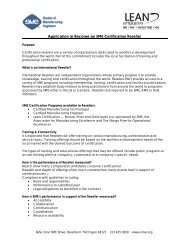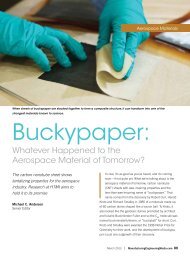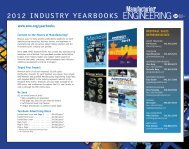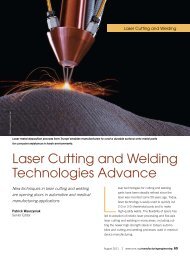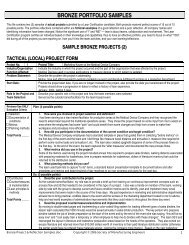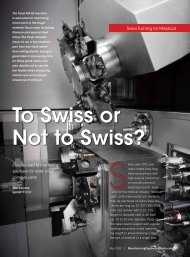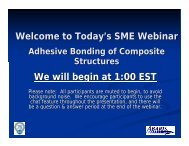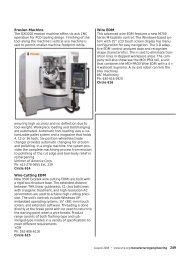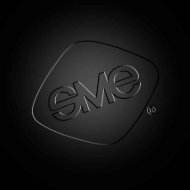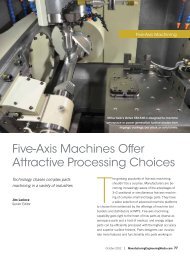The RAPID 2013 Conference & Exposition Directory - Society of ...
The RAPID 2013 Conference & Exposition Directory - Society of ...
The RAPID 2013 Conference & Exposition Directory - Society of ...
Create successful ePaper yourself
Turn your PDF publications into a flip-book with our unique Google optimized e-Paper software.
models from actual patient anatomy. <strong>The</strong> models are created<br />
with an interdisciplinary approach that repurposes traditional<br />
and modern modeling techniques (e.g. lost wax castings from<br />
3D-printed models). Wax RP, now accurate within 10 microns, is<br />
used to create the model core, which is then translated into a<br />
metal core via casting. <strong>The</strong> polished metal core is embedded into<br />
an optically clear urethane block and the metal is subsequently<br />
evacuated. In addition to flow models for experiments, providing<br />
a surgeon with a to-scale and highly accurate representation <strong>of</strong><br />
patient-specific anatomy may lead to better-informed surgical<br />
decisions. This interdisciplinary modeling leverages the latest<br />
wax-RP technology to create accurate, scale vascular models in<br />
a cost- and-time-effective manner.<br />
3:30–3:55 pm<br />
Streamlining the Biomodeling and Biomedical<br />
Design and Development Processes<br />
Arif Sirinterlikci, PhD, Pr<strong>of</strong>essor <strong>of</strong> Engineering/Interim Head,<br />
Robert Morris University<br />
can be used to guide tissue regeneration. We have previously<br />
demonstrated the use <strong>of</strong> a commercial continuous Digital Light<br />
Processing (cDLP) device to prepare bone tissue engineering<br />
implants from poly(propylene fumarate) (PPF) using one dye,<br />
titanium dioxide, and one photo crosslinking initiator, Bis(2,4,6-<br />
trimethylbenzoyl)-phenylphosphineoxide (BAPO), with accuracy<br />
in the tens <strong>of</strong> microns. Higher resolution 3D printing <strong>of</strong> these<br />
implants could be used to improve control over pore geometry<br />
and implant resorption. We have recently determined that the<br />
resolution <strong>of</strong> cDLP-rendered PPF implants can be increased<br />
through the use <strong>of</strong> two dyes, titanium dioxide and oxybenzone<br />
(2-Hydroxy-4-methoxybenzophenone), along with BAPO. It<br />
appears that titanium dioxide alone acts to scatter, and therefore<br />
block, incoming light. This controls resolution in the “Z”<br />
direction. Oxybenzone appears to absorb, and therefore block,<br />
the scattering <strong>of</strong> light laterally, thereby controlling resolution in<br />
the “X” and “Y” directions. <strong>The</strong>se two dyes also appear to allow<br />
delivery <strong>of</strong> more light energy, resulting in fuller crosslinking and<br />
improved post-fabrication handling <strong>of</strong> this s<strong>of</strong>t implant material.<br />
<strong>The</strong> main objective <strong>of</strong> this study is to present case studies which<br />
are being utilized in streamlining the biomodeling and consequent<br />
prosthetics design and development processes. <strong>The</strong> presenters<br />
will move from medical imaging into CAD design environments<br />
by explaining each step <strong>of</strong> the processes. Mimics, 3-Matic,<br />
and Geomagic Studio tools will be included in their respective<br />
steps. <strong>The</strong> presentation will conclude with a research section,<br />
outlining the possibility <strong>of</strong> employing these processes in design,<br />
development, and fabrication <strong>of</strong> orthoses such as cranial helmets,<br />
braces and many more. <strong>The</strong> role <strong>of</strong> RP Technologies will help<br />
finalize the argument for the customized orthotics development<br />
and manufacturing.<br />
4–4:25 pm<br />
Continuous Digital Light Processing (cDLP) for the<br />
Highly Accurate 3D Printing <strong>of</strong> Tissue Engineering<br />
Bone Implants<br />
David Dean, PhD, Associate Pr<strong>of</strong>essor,<br />
Case Western Reserve University<br />
4:30–4:55 pm<br />
Customized Surgical Instrument for Maxill<strong>of</strong>acial<br />
Surgery by SLM: Case Study, Process Steps,<br />
Powder Specifications<br />
Adeline Riou, Marketing Deputy Director, ERASTEEL<br />
Fermin Garciandia, Senior Researcher,<br />
Materials & Processes Area, IK4-LORTEK<br />
Jaime Ochoa, Researcher,<br />
Materials & Processes Area, IK4-LORTEK<br />
This presentation also highlights the benefits <strong>of</strong> technical<br />
cooperation between surgeons, users <strong>of</strong> additive manufacturing<br />
equipment and metallic powder producers. <strong>The</strong> paper is<br />
coauthored by IK4-Lortek, an R&D center with a research line<br />
focused on laser additive manufacturing (including both SLM<br />
and metal deposition technologies); Erasteel, producer <strong>of</strong> tailor<br />
made fine metal powders for additive manufacturing by VIM gas<br />
atomization; and has enjoyed the cooperation <strong>of</strong> Basurto Hospital.<br />
Highly accurate three-dimensional (3D) printing (i.e., additive<br />
manufacturing) <strong>of</strong> resorbable, internally porous, polymer<br />
implants could prove useful for tissue engineering applications.<br />
<strong>The</strong> geometry <strong>of</strong> the internal pore spaces <strong>of</strong> these implants<br />
6/<strong>2013</strong> – <strong>RAPID</strong> 37





